Ranthambore
 Ranthambore is a national park and tiger reserve in Rajasthan state of western India. It is located in Sawai Madhopur district of southeastern Rajasthan, about about 130 km from Jaipur, which is also the nearest airport. The nearest town and railway station is at Sawai Madhopur, 11 km away.
Ranthambore is a national park and tiger reserve in Rajasthan state of western India. It is located in Sawai Madhopur district of southeastern Rajasthan, about about 130 km from Jaipur, which is also the nearest airport. The nearest town and railway station is at Sawai Madhopur, 11 km away.
HOW TO REACH
By Air - The nearest airport to Ranthambore is Jaipur, the capital of the state of Rajasthan. Jaipur is located at a distance of 140 Km from Ranthambore. You can arrive in Jaipur by flights from any major city in India, such as Delhi or Mumbai and then travel to Sawai Madhopur by train or road transport.
By Road - You can easily travel to Ranthambore by road from anywhere in Rajasthan. Both the Rajasthan Tourism Department and many private operators run road transport services to Ranthambore. You can choose from local buses, luxury coaches or private taxis to travel by road to Ranthambore National Park.
By Rail - The main railway line from Delhi to Mumbai runs past Sawai Madhopur, which is connected by regular trains from cities across Rajasthan and India. You can travel to Sawai Madhopur by train and then cover the remaining 11 Km to Ranthambore by taxi.
WHEN TO GO
Best time to travel Ranthambore is between October and March.
WHAT TO SEE
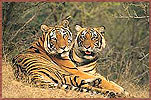 Ranthambore National Park - The park lies at the edge of a plateau, and is bounded to the north by the Banas River and to the south by the Chambal River. It is named for the historic Ranthambore fortress, which lies within the national park. The park covers an area of 392 km², and is famous for its tiger population, and is one of India’s Project Tiger reserves. Other major wild animals include the leopard, dhole, wild pig, sambar, chital and the gaur. Major wild animals found in the national park include the tiger, leopard, nilgai, dhole, wild pig, sambar, chital and the gaur. It is also home to wide variety of trees, plants, birds and reptiles.
Ranthambore National Park - The park lies at the edge of a plateau, and is bounded to the north by the Banas River and to the south by the Chambal River. It is named for the historic Ranthambore fortress, which lies within the national park. The park covers an area of 392 km², and is famous for its tiger population, and is one of India’s Project Tiger reserves. Other major wild animals include the leopard, dhole, wild pig, sambar, chital and the gaur. Major wild animals found in the national park include the tiger, leopard, nilgai, dhole, wild pig, sambar, chital and the gaur. It is also home to wide variety of trees, plants, birds and reptiles.
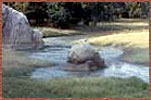 Bakaula - The Bakaula area is an area dotted with little water holes and thick foliage. you’ll get a shivering environment here. Even in peak summers it feels like an air-conditioned room.
Bakaula - The Bakaula area is an area dotted with little water holes and thick foliage. you’ll get a shivering environment here. Even in peak summers it feels like an air-conditioned room.
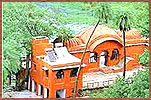 Lakarda & Anantpura - These areas located in the North-Western and Northern regions of the park are ideal locations to visit if looking for Sloth Bears. These areas have a lot of ant hills, which are a favourite of the beers. Although very rarely seen themselves, the pugmarks of the Indian striped Hyenas are often seen here. Their numbers are not very large in the park.
Lakarda & Anantpura - These areas located in the North-Western and Northern regions of the park are ideal locations to visit if looking for Sloth Bears. These areas have a lot of ant hills, which are a favourite of the beers. Although very rarely seen themselves, the pugmarks of the Indian striped Hyenas are often seen here. Their numbers are not very large in the park.
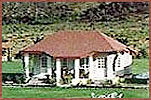 Raj Bagh Ruins - These ruins are located between the Padam Talao (lake) and the Raj Bagh Talao. These ancient stone structures like arches, palace outhouses, domes and steps give the area an aura that is not possible to find anywhere else in the world. Especially if you include the jungle surroundings and are one of the lucky few who come across one of the resident tigers. These ruins are what give the Ranthambore National Park such a unique mixture of a wildlife reserve and a reminder of the past, which together make it one of the most picturesque parks in the entire world.
Raj Bagh Ruins - These ruins are located between the Padam Talao (lake) and the Raj Bagh Talao. These ancient stone structures like arches, palace outhouses, domes and steps give the area an aura that is not possible to find anywhere else in the world. Especially if you include the jungle surroundings and are one of the lucky few who come across one of the resident tigers. These ruins are what give the Ranthambore National Park such a unique mixture of a wildlife reserve and a reminder of the past, which together make it one of the most picturesque parks in the entire world.
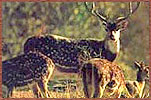 Padam Talao - This is the largest of the lakes present in the park. The famous and beautiful Jogi Mahal is located at the very edge of this lake. When in season, the water lilies that give the lake it’s name, can be seen in plenty. In the early hours of the morning and just before sunset, animals can be seen in large numbers on the lake side. It is in the shallow waters of this lake that the famous “lake hunters” of Ranthambore operate, the most legendary of which was the tiger, Genghis. It is also along this lake’s edges that the rare sighting of the chinkara is most probable.
Padam Talao - This is the largest of the lakes present in the park. The famous and beautiful Jogi Mahal is located at the very edge of this lake. When in season, the water lilies that give the lake it’s name, can be seen in plenty. In the early hours of the morning and just before sunset, animals can be seen in large numbers on the lake side. It is in the shallow waters of this lake that the famous “lake hunters” of Ranthambore operate, the most legendary of which was the tiger, Genghis. It is also along this lake’s edges that the rare sighting of the chinkara is most probable.
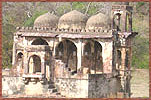 Ranthambore Fort - This fort stands majestically atop a hill overlooking the entire park. The walk up, one of the only places this mode of transport is possible, is a very refreshing and exciting one as even the big cats have been spotted up there! The view of the surrounding keeps getting better and better as you go up but the view from the fort itself can only be described as breathtaking. It is advisable to take along a good pair of binoculars and if possible a camera with a very powerful lens when visiting the fort.
Ranthambore Fort - This fort stands majestically atop a hill overlooking the entire park. The walk up, one of the only places this mode of transport is possible, is a very refreshing and exciting one as even the big cats have been spotted up there! The view of the surrounding keeps getting better and better as you go up but the view from the fort itself can only be described as breathtaking. It is advisable to take along a good pair of binoculars and if possible a camera with a very powerful lens when visiting the fort.
The soaring Serpent eagles, vultures and other birds can be seen at eye level. Many animals can also be seen along the edges of all the water bodies, which are all visible from here. The fort itself also offers many interesting architectural and historical sights worth viewing and photographing. A trip to the fort is a must if you are a first time visitor to the park. A guide with a good knowledge of the fort’s history would always be a good idea.
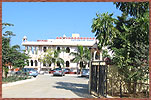 Rajabagh Talao - This is probably the most picturesque of the three lakes. This mostly due to the ruins that can be seen along it’s edges. Yet, it owes some of it’s beauty to the animals that seem to always flock to it’s waters. It always has a large population of animals and birds feeding in it. The sambhar deer at Ranthambore have adapted to eating plants from the lake floor and nowhere is it more evident than at the Rajbagh Talao. Many birds, like egrets, can be seen riding on these deer while they feed. The areas around the Rajbagh Talao are also prime tiger spotting areas due to the kind of forest and it’s accessibility to water sources.
Rajabagh Talao - This is probably the most picturesque of the three lakes. This mostly due to the ruins that can be seen along it’s edges. Yet, it owes some of it’s beauty to the animals that seem to always flock to it’s waters. It always has a large population of animals and birds feeding in it. The sambhar deer at Ranthambore have adapted to eating plants from the lake floor and nowhere is it more evident than at the Rajbagh Talao. Many birds, like egrets, can be seen riding on these deer while they feed. The areas around the Rajbagh Talao are also prime tiger spotting areas due to the kind of forest and it’s accessibility to water sources.
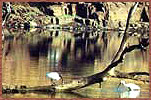 Malik Talao - This is the smallest of the three lakes in Ranthambore National Park. But, as they say, all the best things come in small packages. This definitely holds true for Malik Talao. It is an area full of concentrated action all the time. It always seems to have a healthy population of birds of all kinds. Also seen at the lake very clearly and from a reasonably close distance and handsome specimens of the Indian Marsh Crocodiles. It is quite common here to be able to watch a kingfisher on a hunt for small fish.
Malik Talao - This is the smallest of the three lakes in Ranthambore National Park. But, as they say, all the best things come in small packages. This definitely holds true for Malik Talao. It is an area full of concentrated action all the time. It always seems to have a healthy population of birds of all kinds. Also seen at the lake very clearly and from a reasonably close distance and handsome specimens of the Indian Marsh Crocodiles. It is quite common here to be able to watch a kingfisher on a hunt for small fish.
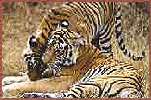 Kachida Valley - This valley, which consists of many rocky outcrops and low hills, is located close to the outskirts of the park. A jeep would be the ideal mode of transport when trying to visit this area. This area contains a majority of the Panther population of the park. The panthers avoid venturing into the main jungle to avoid conflicts with tigers, who are known to kill them. This area also has a good population of beers.
Kachida Valley - This valley, which consists of many rocky outcrops and low hills, is located close to the outskirts of the park. A jeep would be the ideal mode of transport when trying to visit this area. This area contains a majority of the Panther population of the park. The panthers avoid venturing into the main jungle to avoid conflicts with tigers, who are known to kill them. This area also has a good population of beers.
WHERE TO EAT
You can try the restaurants at the luxury hotels.








